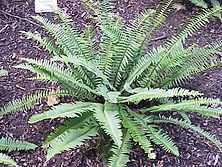Polystichum
| Polystichum | |
|---|---|
 | |
| Polystichum setiferum | |
| Scientific classification | |
| Kingdom: | Plantae |
| Division: | Pteridophyta |
| Class: | Pteridopsida |
| Order: | Polypodiales |
| Family: | Dryopteridaceae |
| Genus: | Polystichum Roth 1800 |
| Species | |
|
See text. | |
| Synonyms | |
| |
Polystichum is a genus of about 260 species of ferns with a cosmopolitan distribution. The highest diversity is in eastern Asia, with about 120 species in China alone; the region from Mexico to Brazil has nearly 100 additional species; Africa (17 species), North America (15 species), and Europe (5 species) have much lower diversity. Polystichum species are terrestrial or rock-dwelling ferns of warm-temperate and montane-tropical regions (a few species grow in alpine regions).
Description

Many ferns of this genus have stout, slowly creeping rootstocks that form a crown, with a vase-like ring of evergreen fronds 30–200 cm long. The sori are round, with a circular indusium. The stipes have prominent scales. The genus differs from Dryopteris in the indusium being circular, not reniform, and in having stronger, more persistent fronds with a harder, somewhat rough, texture.
Cultivation
Several species are grown as ornamental plants in gardens. One species, Polystichum tsus-simense of eastern Asia, is commonly offered as a houseplant.
Hybrids
Hybridisation is frequent in the genus, with several named hybrids, including:-
- P. × bicknellii (P. aculeatum × P. setiferum)
- P. × illyricum (P. aculeatum × P. lonchitis)
- P. × lonchitiforme (P. lonchitis × P. setiferum)
- P. × lesliei (P. setiferum × P. munitum) first found in Surrey in 1995 and a second plant found in Cornwall in 2001.[2]
Ecology
Polystichum species are used as food plants by the larvae of some Lepidoptera species including Pharmacis fusconebulosa. Specimens of some of these can be found at the Royal Botanic Gardens, Sydney.
Selected species
The genus Polystichum includes, but is not limited to, the following species. In this list, a species name preceded by (=) is considered to be a synonym of the accepted species name above it.
|
|
Former species
Species that were at one time considered part of the Polystichum genus, but are now categorized elsewhere, include:
- Polystichum auriculatum (L.) C.Presl 1836 = Dryopteris auriculata (L.) Kuntze 1891[32]
- Polystichum falcatum (L.f.) Diels 1899 = Cyrtomium falcatum (L.f.) C.Presl[33] – Japanese Holly Fern
- Polystichum lepidocaulon (Hook.) J.Sm. 1866 = Cyrtomidictyum lepidocaulon (Hook.) Ching 1940[34]
References
- ↑ Synonyms Tropicos.org. Missouri Botanical Garden. 25 Jan 2012
- ↑ Murphy, Rosaline J; Page, Christopher N, Parslow, Rosemary E and Bennallick, Ian J (2012). Ferns, Clubmosses, Quillworts and Horsetails of Cornwall and the Isles of Scilly. Truro: ERCCIS. ISBN 978 1 902864 07 5.
- ↑ P. andersonii, USDA Natural Resources Conservation Service PLANTS Profile, 19 Jan 2012
- ↑ P. bonseyi Tropicos.org. Missouri Botanical Garden. 19 Jan 2012
- ↑ P. bonseyi, USDA Natural Resources Conservation Service PLANTS Profile, 19 Jan 2012
- ↑ P. brachypterum, USDA Natural Resources Conservation Service PLANTS Profile, 19 Jan 2012
- ↑ P. braunii, USDA Natural Resources Conservation Service PLANTS Profile, 19 Jan 2012
- ↑ P. brachypterum Tropicos.org. Missouri Botanical Garden. 19 Jan 2012
- ↑ P. capillipes Tropicos.org. Missouri Botanical Garden. 20 Jan 2012
- ↑ P. echinatum, Tropicos.org. Missouri Botanical Garden., 19 Jan 2012
- ↑ P. kiusiuense Tropicos.org. Missouri Botanical Garden. 20 Jan 2012
- ↑ P. haleakalense, USDA Natural Resources Conservation Service PLANTS Profile, 19 Jan 2012
- ↑ Conspectus of Southern African Pteridophyta, J. P. Roux, Nov. 2001. p. 129
- ↑ P. mollissimum Tropicos.org. Missouri Botanical Garden. 20 Jan 2012
- ↑ P. nakenense Chinese Plant Names www.eFloras.org 20 Dec 2012
- ↑ P. neolobatum Tropicos.org. Missouri Botanical Garden. 19 Jan 2012
- ↑ P. ordinatum Tropicos.org. Missouri Botanical Garden. 19 Jan 2012
- ↑ P. erinaceum Tropicos.org. Missouri Botanical Garden. 19 Jan 2012
- ↑ P. brunneum Tropicos.org. Missouri Botanical Garden. 19 Jan 2012
- ↑ P. setigerum, USDA Natural Resources Conservation Service PLANTS Profile, 20 Jan 2012
- ↑ P. lichiangense Tropicos.org. Missouri Botanical Garden. 20 Jan 2012
- ↑ P. sinense Tropicos.org. Missouri Botanical Garden. 19 Jan 2012
- ↑ P. apicisterile Tropicos.org. Missouri Botanical Garden. 19 Jan 2012
- ↑ P. integripinnulum Tropicos.org. Missouri Botanical Garden. 20 Jan 2012
- ↑ P. conaense Tropicos.org. Missouri Botanical Garden. 19 Jan 2012
- ↑ P. ilicifolium Tropicos.org. Missouri Botanical Garden. 20 Jan 2012
- ↑ P. heteropaleaceum Tropicos.org. Missouri Botanical Garden. 20 Jan 2012
- ↑ P. kodamae Tropicos.org. Missouri Botanical Garden. 20 Jan 2012
- ↑ P. xiphophyllum Tropicos.org. Missouri Botanical Garden. 20 Jan 2012
- ↑ P. gyirongense Tropicos.org. Missouri Botanical Garden. 19 Jan 2012
- ↑ P. jizhushanense Tropicos.org. Missouri Botanical Garden. 20 Jan 2012
- ↑ P. auriculatum Tropicos.org. Missouri Botanical Garden. 19 Jan 2012
- ↑ P. falcatum Tropicos.org. Missouri Botanical Garden. 19 Jan 2012
- ↑ P. lepidocaulon Tropicos.org. Missouri Botanical Garden. 20 Jan 2012
Gallery


